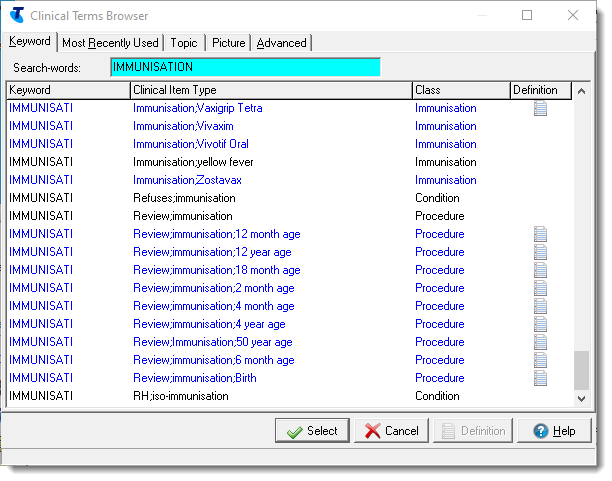Add a clinical item to a patient's record
Record a patient's history, conditions, check ups, procedures, immunisations, referrals, admissions and alerts using clinical items.
- Calculator - assessment and audit clinical items, for example, for Kessler 10 for mental health assessment or alcohol consumption audit
- Check up - general items, for example, for Aboriginal and Torres Strait Islander or Women's Health check-ups
- Child health - items for children's check-ups including birth and age-based development checks
- Enrolment - items for enrolment in alcohol-related programmes
- Examination - items for examinations grouped by clinical item topics, for example, cardiovascular or respiratory
- Group - items for group work, for example, counselling or educational groups
- HACC/CHSP - items related to HACC or CHSP
- Immunisation - items for immunisations
- Referral - clinical items for referrals grouped by specialty, for example, dentist or paediatrician. Specialists should be included in the Address Book and marked for Referrals.
- STI - clinical items for STI screening or treatment.
- Shortcut to a clinical item for commonly used clinical items
- Clinical items search
-
In the patient's clinical record, click
 Clinical Item or press
F11.
Clinical Item or press
F11.

- In the Search-words field, enter a term you would expect to find in the clinical item.
- Alternatively, go to the tab that is most likely to show the clinical item you need.
- Double-click the clinical item you require.
-
In the Clinical Item, complete as much information as you want to,
including:
- In the Comment field, enter any observations.
- From the From Date calendar, select when the symptoms are reported to have started.
- Set Display on Main Summary if this is a significant, active health event that should be given prominence on the main summary.
- If required, set Reason for Encounter to indicate that this is either the main reason for encounter, or if Reason For Visit is also enabled, one of up to four reasons for the patient's visit.
- Click Save.
- In the shortcut bar, click the required group and select the required
clinical item from the list.

- Complete the required fields.
- Click Save.
Information you provided in the clinical item is displayed on the Progress Notes tab and is summarised on the Detail tab.
To print a clinical item, click Print & Save. After printing the clinical item, your changes are saved and the item is closed.
If the clinical item currently being added is a Referral, you can generate a CDA e-Referral document for the patient. An e-Referral can be uploaded to the My Health Record or sent via Secure Messaging within the first 8 hours of saving the document. To generate an e-Referral, click Save & Create eReferral. The clinical item is saved and closed, and an e-Referral is opened. To learn more about the e-Referral document type, see e-Referrals.
